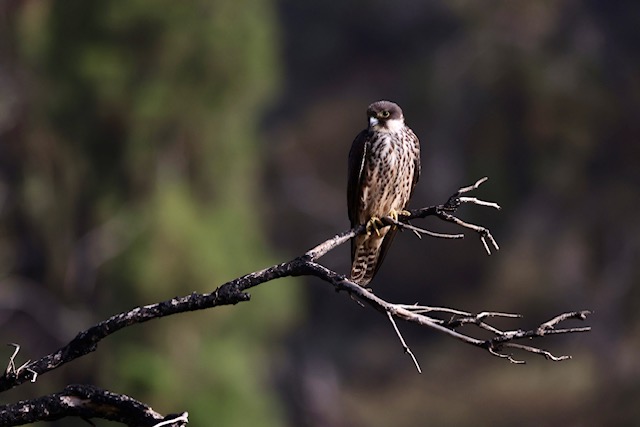Este verano ha habido que lamentar un incendio en la maravillosa zona de las Cumbres de Gran Canaria. Pese a que logró sofocarse rápidamente, este incendio, iniciado el pasado 25 de julio, arrasó unas 480 hectáreas, siendo catalogado como el mayor incendio forestal de la isla desde 2019. Afortunadamente, el fuego provocó pocos daños a las masas de pino canario. Esa zona es visitada con frecuencia por halcones de Eleonor, sobre todo cuando las condiciones de viento no son favorables para la llegada de pequeñas aves migratorias al archipiélago. Los halcones encuentran en esa zona insectos de los que pueden alimentarse, a la espera de que el flujo de aves migrantes alcance sus áreas de nidificación.
A lo largo de los años, distintos compañeros nos han proporcionado valiosas observaciones de halcones de Eleonor de distintas edades, alguno de ellos anillado. Hace pocos días, el 8 de agosto, Jesús García Ubierna pudo observar y fotografiar algunos ejemplares en las Cumbres. Aunque esta hembra de morfo claro se encontraba a gran distancia, se aprecia bien la anilla de plástico de color rojo que porta, con código [LR]. Esto nos ha permitido saber que dicha hembra fue anillada como pollo en septiembre de 2017 en el islote de Montaña Clara. Esta es la primera lectura de este individuo tras su anillamiento, lo cual es un dato muy valioso. Es muy probable que esté criando (normalmente lo hacen por primera vez a los 2-3 años), pero, lamentablemente, no sabemos en qué islote…
Un par de días después, Jesús logró fotografiar a este ejemplar joven que, en esta ocasión, no estaba anillado.
El anillamiento científico resulta una herramienta esencial que permite obtener información sobre los ejemplares durante toda su vida, y es fundamental para conocer aspectos básicos de su biología, como los lugares que visita, a qué edad comienza a reproducirse, su éxito reproductor y, en definitiva, su historia vital.
This summer there has been a big fire in the wonderful area of Las Cumbres de Gran Canaria. Despite the fact that it was quickly put out, this fire, which started on July 25th, devastated ca. 480 hectares, being classified as the largest forest fire on the island since 2019. Fortunately, the fire caused little damage to the Canary Island pine forest. This area is frequently visited by Eleanora’s falcons, especially when the wind conditions are not favorable for the arrival of small migratory birds to the archipelago. Falcons find insects in this area that they can feed on, waiting for the flow of migrating birds to reach their nesting areas.
Over the years, different peers have provided us valuable observations of Eleanora’s falcons of different ages, some of them ringed. A few days ago, on August 8th, Jesús García Ubierna was able to observe and photograph some individuals in las Cumbres. Although this pale morph female was at a great distance, the red plastic ring that she wears [LR] can be clearly seen. This has allowed us to know that this female was ringed as a fledgling in September 2017 on the islet of Montaña Clara. This is the first reading of this individual after her ringing, which is very valuable information. It is very likely that she is breeding (they usually do for the first time at 2-3 years old), but sadly we don’t know on which islet…
A couple of days later, Jesús managed to photograph this young specimen that, on this occasion, was not ringed.
Scientific ringing is an essential tool that allows obtaining information about the individuals throughout their lives, and it is essential to know basic aspects of their biology, such as the places they visit, at what age they recruit and begin to reproduce, their reproductive success and, ultimately, its life story.




